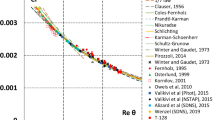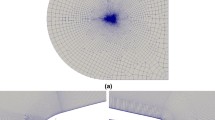Abstract
Computations of turbulent trailing-edge flow have been carried out at a Reynolds number of 1000 (based on the free-stream quantities and the trailing-edge thickness) using an unsteady 3D Reynolds-Averaged Navier–Stokes (URANS) code, in which two-equation (k–ε) turbulence models with various low-Re near wall treatments were implemented. Results from a direct numerical simulation (DNS) of the same flow are available for comparison and assessment of the turbulence models used in the URANS code. Two-dimensional URANS calculations are carried out with turbulence mean properties from the DNS used at the inlet; the inflow boundary-layer thickness is 6.42 times the trailing-edge thickness, close to typical turbine blade flow applications. Many of the key flow features observed in DNS are also predicted by the modelling; the flow oscillates in a similar way to that found in bluff-body flow with a von Kármán vortex street produced downstream. The recirculation bubble predicted by unsteady RANS has a similar shape to DNS, but with a length only half that of the DNS. It is found that the unsteadiness plays an important role in the near wake, comparable to the modelled turbulence, but that far downstream the modelled turbulence dominates. A spectral analysis applied to the force coefficient in the wall normal direction shows that a Strouhal number based on the trailing-edge thickness is 0.23, approximately twice that observed in DNS. To assess the modelling approximations, an a priori analysis has been applied using DNS data for the key individual terms in the turbulence model equations. A possible refinement to account for pressure transport is discussed.
Similar content being viewed by others
References
Dawes, W.N., The practical application of solution-adaptive to the numerical solution of complex turbomachinery problems. Progr. Aerospace Sci. 29 (1993) 221-269.
Durbin, P.A., Separated flow computations with the k-ɛ-v 2 model. AIAA J. 33(4) (1995) 659-664.
Gao, S.A., Voke, P.R. and Gough, T.D., Turbulent simulation of a flat plate boundary layer and near wake. In: Chollet, J.P., Voke, P.R. and Kleiser, L. (eds.), Direct and Large Eddy Simulation II. Kluwer Academic Publishers, Dordrecht (1997) pp. 115-124.
Gough, T.D. and Hancock, P.E., Lower Reynolds number turbulent near wakes. In: Gavrilakis, S., et al. (eds.), Advances in Turbulence VI. Kluwer Academic Publishers, Dordrecht (1996) pp. 445-448.
Hanjalic, K. and Launder, B.E., Contribution towards a Reynolds-stress closure for low-Reynolds-number turbulence. J. Fluid Mech. 74 (1976) 593-610.
Hannemann, K. and Oertel, H., Numerical simulation of the absolutely and convectively unstable wake. J. Fluid Mech. 199 (1989) 55-88.
Howard, R.J.A., Alam, M. and Sandham, N.D., Two-equation turbulence modelling of a transitional separation bubbles. Flow, Turbul. Combustion 63(1-4) (2000) 175-191.
Kawamura, H., A k-ɛ-v 2 model with special relevance to the near wall-turbulence. In: Eighth Symposium on Turbulent Shear Flows, Munich, September 9-11 (1991) Volume 2, Paper 26-4, pp. 1-6 (unpublished).
Kawamura, H. and Kawashima, N., A proposal of k-ɛ model with relevance to the near wall-turbulence. In: International Symposium on Turbulence, Heat and Mass Transfer, Lisbon (1995).
Lam, C.K.G. and Bremhorst, K.A., Modified form of the k-ɛ model for the predicting wall turbulence. J. Fluids Engrg. 103 (1981) 456-460.
Parneix, S., Laurence, D. and Durbin, P.A., A procedure for using DNS databases. Trans. ASME, J. Fluids Engrg. 120(3) (1998) 40-47.
Patel, V.C., Rodi, W. and Scheuerer, G., Turbulence models for near-wall flows and low Reynolds numbers: A review. AIAA J. 23(9) (1985) 1308-1319.
Rotta, J.C., Turbulent boundary layers in incompressible flow. Progr. Aeronautical Sci. 2 (1962) 1-219.
Savill, A.M., One-point closure applied to by-pass transition. In: Hallback, M., et al. (eds.), Turbulence and Transition Modelling. Kluwer Academic Publishers, Dordrecht (1996) pp. 233-268.
Spalart, P.R., Direct simulation of a turbulent boundary layer up to Reθ = 1410. J. Fluid Mech. 187 (1988) 61-98.
Thomas, T.G., Yao, Y.F. and Sandham, N.D., Structure and energetics of a turbulent trailing edge flow. Comput. Math. Appl. (2002) to appear.
Watterson, J.K., Dawes, W.N., Savill, A.M. and White, A.J., Predicting turbulent flow in a staggered tube bundle. Internat. J. Heat Fluid Flow 20(6) (1999) 581-591.
Yang, Z. and Shih, T.H., New time-scale based k-ɛ model for near wall turbulence. AIAA J. 31(7) (1993) 1191-1198.
Yang, Z. and Shih, T.H., A Galilean and tensorial invariant k-ɛ model for near wall turbulence. AIAA Paper 93-3105 (1993).
Yao, Y.F., Thomas, T.G., Sandham, N.D. and Williams, J.J.R., Direct numerical simulation of turbulent flow over a rectangular trailing edge. Theoret. Comput. Fluid Dynam. 14 (2001) 337-358.
Roshko, A., On the drag and shedding frequency of two dimensional bluff bodies. NACA TN3169 (1954).
Author information
Authors and Affiliations
Rights and permissions
About this article
Cite this article
Yao, Y., Savill, A., Sandham, N. et al. Simulation and Modelling of Turbulent Trailing-Edge Flow. Flow, Turbulence and Combustion 68, 313–333 (2002). https://doi.org/10.1023/A:1021755327045
Issue Date:
DOI: https://doi.org/10.1023/A:1021755327045




